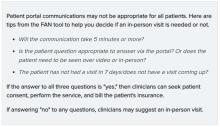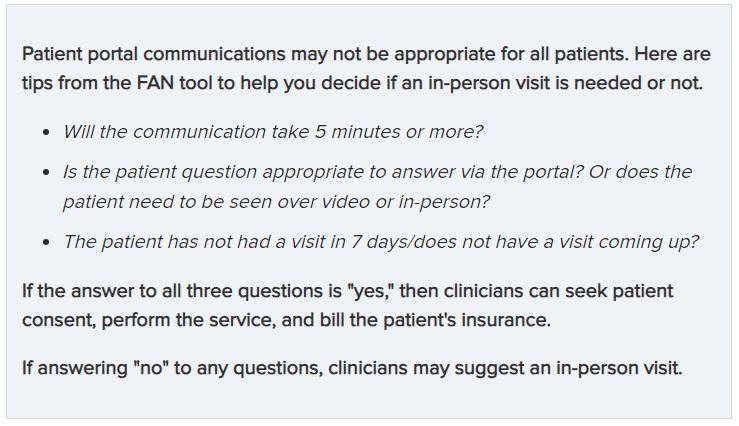User login
BOSTON — Online patient portals have shifted patient expectations of how quickly clinicians respond and provide timely care, which can lead to burnout. But asynchronous care can, in some cases, be compensated and increase physician productivity and enhance patient care, according to experts who led a workshop at the Society of General Internal Medicine (SGIM) 2024 Annual Meeting.
Patient portal visits have increased in popularity and use since the COVID-19 pandemic. For primary care clinicians especially, the amount of time spent and the span of requests, from messages with new health concerns to requests for prescription refills, can be daunting.
“Understanding the nuances of these relationships is pivotal in navigating the evolution toward asynchronous care,” said Jennifer Schmidt, MD, an assistant professor of medicine at the Washington University School of Medicine in St. Louis, who co-moderated the workshop.
But patient portals can give clinicians another tool to deliver care beyond conventional office visits or telemedicine appointments, Dr. Schmidt said.
Clinicians can bill insurance if their response to a patient question takes longer than 5 minutes to compose. Responses to messages related to scheduling appointments, refilling prescriptions, or visit follow-ups are not billable.
Some participants at the session said their employers do not have policies that allow compensation for their work in patient portals. Others said their health systems have reported that patients who use portals more frequently have higher satisfaction scores.
Asynchronous care holds promise for extending care beyond traditional constraints, according to Stephen Fuest, MD, an assistant professor of internal medicine at the University of Colorado Anschutz Medical Campus in Aurora, Colorado, and a co-moderator of the workshop.
“By capitalizing on our experiences in designing and implementing systems for portal communication, we can find ways to optimize productivity and alleviate burnout,” Dr. Fuest said.
Dr. Fuest noted that while compensation rates for virtual care are lower than those for in-person, the lack of geographical barriers and time constraints allow clinicians to care for more patients. Asynchronous care also can limit losing patients to follow-up.
One participant noted that the use of the patient portal may increase disparities in care among non-English speaking patients who are unable to interpret communications or clinician notes.
Still, Dr. Schmidt said that asynchronous care is only as successful as the trust and rapport built between the clinician and the patient.
“Asynchronous care isn’t just a technological advancement, it’s a testament to the commitment to patient-centric care,” she said. “By embracing innovation responsibly, we’re ushering healthcare delivery characterized by efficiency, empathy, and empowerment.”
The moderators reported no relevant disclosures.
A version of this article first appeared on Medscape.com.
BOSTON — Online patient portals have shifted patient expectations of how quickly clinicians respond and provide timely care, which can lead to burnout. But asynchronous care can, in some cases, be compensated and increase physician productivity and enhance patient care, according to experts who led a workshop at the Society of General Internal Medicine (SGIM) 2024 Annual Meeting.
Patient portal visits have increased in popularity and use since the COVID-19 pandemic. For primary care clinicians especially, the amount of time spent and the span of requests, from messages with new health concerns to requests for prescription refills, can be daunting.
“Understanding the nuances of these relationships is pivotal in navigating the evolution toward asynchronous care,” said Jennifer Schmidt, MD, an assistant professor of medicine at the Washington University School of Medicine in St. Louis, who co-moderated the workshop.
But patient portals can give clinicians another tool to deliver care beyond conventional office visits or telemedicine appointments, Dr. Schmidt said.
Clinicians can bill insurance if their response to a patient question takes longer than 5 minutes to compose. Responses to messages related to scheduling appointments, refilling prescriptions, or visit follow-ups are not billable.
Some participants at the session said their employers do not have policies that allow compensation for their work in patient portals. Others said their health systems have reported that patients who use portals more frequently have higher satisfaction scores.
Asynchronous care holds promise for extending care beyond traditional constraints, according to Stephen Fuest, MD, an assistant professor of internal medicine at the University of Colorado Anschutz Medical Campus in Aurora, Colorado, and a co-moderator of the workshop.
“By capitalizing on our experiences in designing and implementing systems for portal communication, we can find ways to optimize productivity and alleviate burnout,” Dr. Fuest said.
Dr. Fuest noted that while compensation rates for virtual care are lower than those for in-person, the lack of geographical barriers and time constraints allow clinicians to care for more patients. Asynchronous care also can limit losing patients to follow-up.
One participant noted that the use of the patient portal may increase disparities in care among non-English speaking patients who are unable to interpret communications or clinician notes.
Still, Dr. Schmidt said that asynchronous care is only as successful as the trust and rapport built between the clinician and the patient.
“Asynchronous care isn’t just a technological advancement, it’s a testament to the commitment to patient-centric care,” she said. “By embracing innovation responsibly, we’re ushering healthcare delivery characterized by efficiency, empathy, and empowerment.”
The moderators reported no relevant disclosures.
A version of this article first appeared on Medscape.com.
BOSTON — Online patient portals have shifted patient expectations of how quickly clinicians respond and provide timely care, which can lead to burnout. But asynchronous care can, in some cases, be compensated and increase physician productivity and enhance patient care, according to experts who led a workshop at the Society of General Internal Medicine (SGIM) 2024 Annual Meeting.
Patient portal visits have increased in popularity and use since the COVID-19 pandemic. For primary care clinicians especially, the amount of time spent and the span of requests, from messages with new health concerns to requests for prescription refills, can be daunting.
“Understanding the nuances of these relationships is pivotal in navigating the evolution toward asynchronous care,” said Jennifer Schmidt, MD, an assistant professor of medicine at the Washington University School of Medicine in St. Louis, who co-moderated the workshop.
But patient portals can give clinicians another tool to deliver care beyond conventional office visits or telemedicine appointments, Dr. Schmidt said.
Clinicians can bill insurance if their response to a patient question takes longer than 5 minutes to compose. Responses to messages related to scheduling appointments, refilling prescriptions, or visit follow-ups are not billable.
Some participants at the session said their employers do not have policies that allow compensation for their work in patient portals. Others said their health systems have reported that patients who use portals more frequently have higher satisfaction scores.
Asynchronous care holds promise for extending care beyond traditional constraints, according to Stephen Fuest, MD, an assistant professor of internal medicine at the University of Colorado Anschutz Medical Campus in Aurora, Colorado, and a co-moderator of the workshop.
“By capitalizing on our experiences in designing and implementing systems for portal communication, we can find ways to optimize productivity and alleviate burnout,” Dr. Fuest said.
Dr. Fuest noted that while compensation rates for virtual care are lower than those for in-person, the lack of geographical barriers and time constraints allow clinicians to care for more patients. Asynchronous care also can limit losing patients to follow-up.
One participant noted that the use of the patient portal may increase disparities in care among non-English speaking patients who are unable to interpret communications or clinician notes.
Still, Dr. Schmidt said that asynchronous care is only as successful as the trust and rapport built between the clinician and the patient.
“Asynchronous care isn’t just a technological advancement, it’s a testament to the commitment to patient-centric care,” she said. “By embracing innovation responsibly, we’re ushering healthcare delivery characterized by efficiency, empathy, and empowerment.”
The moderators reported no relevant disclosures.
A version of this article first appeared on Medscape.com.

